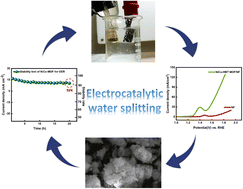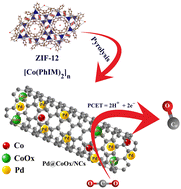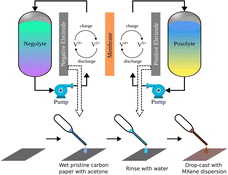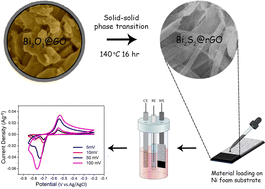
RSC Advances
Subject area
Electrochemical energy articles published in the last
6 months

Enhancing Li+ recovery in brine mining: integrating next-gen emotional AI and explainable ML to predict adsorption energy in crown ether-based hierarchical nanomaterials
Artificial intelligence (AI) is being employed in brine mining to enhance the extraction of lithium, vital for the manufacturing of lithium-ion batteries, through improved recovery efficiencies and the reduction of energy consumption.

RSC Adv., 2024,14, 15129-15142
https://doi.org/10.1039/D4RA02385D
Natural tea polyphenol functionalized graphene anode for simultaneous power production and degradation of methyl orange dye in microbial fuel cells
The microbial fuel cell (MFCs) has dual functions, capable of achieving dye decolorization and synchronous power generation.

RSC Adv., 2024,14, 14847-14856
https://doi.org/10.1039/D4RA00613E
Sodium halide solid state electrolyte of Na3YBr6 with low activation energy
Vibration of Br− during the Na+ ion migration can significantly reduce ion migration activation energy. Therefore, compared to chlorides, bromide should be able to achieve lower migration activation energy and higher Na+ ion conduction.

RSC Adv., 2024,14, 14716-14721
https://doi.org/10.1039/D4RA02663B
Photogalvanics of copper and brass working electrodes in the NaOH-Allura Red-D-galactose-DDAC electrolyte for solar power generation
Experimental setup for the photogalvanics of copper and brass working electrodes (here, A is a digital multimeter used as an ammeter; V is another digital multimeter used as voltmeter; R is a potentiometer/rheostat; K is a key).

RSC Adv., 2024,14, 14648-14664
https://doi.org/10.1039/D4RA01091D
Tailoring NiCoCu layered double hydroxide with Ag-citrate/polyaniline/functionalized SWCNTs nanocomposites for supercapacitor applications
A schematic of the charge storage mechanism in a novel NiCoCu layered double hydroxide/Ag-citrate–polyaniline–functionalized single-walled carbon nanotubes nanocomposite electrode material.

RSC Adv., 2024,14, 14438-14451
https://doi.org/10.1039/D4RA01324G
A sodium ion conducting gel polymer electrolyte with counterbalance between 1-ethyl-3-methylimidazolium tetrafluoroborate and tetra ethylene glycol dimethyl ether for electrochemical applications
For sodium batteries, the development of gel polymer electrolytes (GPEs) with remarkable electrochemical properties is in its early stage and persists to be a challenge.

RSC Adv., 2024,14, 14358-14373
https://doi.org/10.1039/D4RA01615G
MOF/graphene oxide based composites in smart supercapacitors: a comprehensive review on the electrochemical evaluation and material development for advanced energy storage devices
Driving towards sustainable energy solutions: harnessing metal–organic framework/graphene oxide composites to propel high-efficiency smart supercapacitors.

RSC Adv., 2024,14, 14311-14339
https://doi.org/10.1039/D4RA01027B
A review on MOFs synthesis and effect of their structural characteristics for hydrogen adsorption
Climate change is causing a rise in the need to transition from fossil fuels to renewable and clean energy such as hydrogen as a sustainable energy source.

RSC Adv., 2024,14, 14233-14253
https://doi.org/10.1039/D4RA00865K
Elucidating the performance of hexamethylene tetra-amine interlinked bimetallic NiCo-MOF for efficient electrochemical hydrogen and oxygen evolution
This study investigates the electrocatalytic water splitting capabilities of hexamethylene tetra-amine-linked NiCo-MOF, synthesized via hydrothermal approach. It reveals low overpotentials of 274 mV and 330 mV with Tafel slopes of 78 mV dec−1 and 86 mV dec−1 towards HER and OER respectively.

RSC Adv., 2024,14, 13837-13849
https://doi.org/10.1039/D4RA00340C
Scanning electrochemical microscopy for the differentiation of radical-induced degradation mechanisms in polymer electrolyte membranes
In this work, a spatially resolved analytical method based on scanning electrochemical microscopy (SECM) to distinguish different degradation phenomena in polymer electrolyte membranes was developed.

RSC Adv., 2024,14, 13748-13757
https://doi.org/10.1039/D4RA02203C
Preparation of cyclodextrin polymer-functionalized polyaniline/MXene composites for high-performance supercapacitor
PANI was successfully grown in situ on the surface of MXene derived from CDP. The composite exhibited a good specific surface area and high specific capacitance.

RSC Adv., 2024,14, 13685-13693
https://doi.org/10.1039/D4RA02542C
A surface-modified Na3V2(PO4)2F3 cathode with high rate capability and cycling stability for sodium ion batteries
Na3V2(PO4)2F3 is an ideal cathode material for sodium-ion batteries with a high theoretical energy density. In this paper, the electronic conductivity of Na3V2(PO4)2F3 was improved by using a simple surface carbon coating method, and excellent electrochemical properties were obtained.

RSC Adv., 2024,14, 13703-13710
https://doi.org/10.1039/D4RA00427B
Failure mechanisms of the Li(Ni0.6Co0.2Mn0.2)O2-Li4Ti5O12 lithium-ion batteries in long-time high-rate cycle
Through the analysis of tens of thousands of cycles in LTO pouch batteries at a high rate of 40C, we found that the failure was mainly caused by the consumption of electrolyte and the microcracks emerged on the cathode electrode materials NCM622.

RSC Adv., 2024,14, 13592-13604
https://doi.org/10.1039/D4RA00923A
Chemical synthesis and super capacitance performance of novel CuO@Cu4O3/rGO/PANI nanocomposite electrode
Copper oxide-based nanocomposites are promising electrode materials for high-performance supercapacitors due to their unique properties that aid electrolyte access and ion diffusion to the electrode surface.

RSC Adv., 2024,14, 13628-13639
https://doi.org/10.1039/D4RA00065J
Stable cycling and low-temperature operation utilizing amorphous carbon-coated graphite anodes for lithium-ion batteries
The carbon coated graphite prepared by CVD method can meet the stable cycling. The pouch cell GC-2‖LiCoO2 exhibits noteworthy durability, retaining 87% of its capacity even after 1200 cycles at a high charge/discharge rate of 5C/5C.

RSC Adv., 2024,14, 13277-13285
https://doi.org/10.1039/D4RA01560F
Pr2Ni0.8Co0.2O4+δ impregnated La0.6Sr0.4CoO3−δ oxygen electrode for efficient CO2 electroreduction in solid oxide electrolysis cells
The impregnation of PNCO into the LSC anode can effectively improve the electrochemical performance of CO2 in high-temperature electrolysis due to the generation of PNCO nanofilms on the anode.

RSC Adv., 2024,14, 13251-13257
https://doi.org/10.1039/D4RA01848F
1D hollow tubular/2D nanosheet hybrid dimensional porous carbon prepared by one-step carbonization using natural minerals as templates for supercapacitors
1D hollow tubular/2D nanosheet hybrid dimensional porous carbon was synthesized through one-step carbonization using 1D fibrous brucite and 2D layered magnesium carbonate hydroxide as templates.

RSC Adv., 2024,14, 13190-13199
https://doi.org/10.1039/D4RA01873G
High performance electrochemical CO2 reduction over Pd decorated cobalt containing nitrogen doped carbon
Efficient electrocatalytic CO2 reduction reaction (eCO2RR) to various products, such as carbon monoxide (CO), is crucial for mitigating greenhouse gas emissions and enabling renewable energy storage.

RSC Adv., 2024,14, 13017-13026
https://doi.org/10.1039/D4RA01641F
Scalable slot-die coated flexible supercapacitors from upcycled PET face shields
This study reports fabrication of flexible supercapacitor with slot-die coated activated carbon electrodes derived from upcycled PET face shield, displaying excellent energy and power density of 21.8 W h kg−1 and 20 600 W kg−1 with good flexibility.

RSC Adv., 2024,14, 12781-12795
https://doi.org/10.1039/D2RA06809E
Treatment of carbon electrodes with Ti3C2Tx MXene coating and thermal method for vanadium redox flow batteries: a comparative study
Treatment of carbon papers with Ti3C2Tx MXene solution for vanadium redox flow batteries.

RSC Adv., 2024,14, 12807-12816
https://doi.org/10.1039/D4RA01380H
Fabrication of MoS2/rGO hybrids as electrocatalyst for water splitting applications
Environmental degradation and energy constraint are important risks to long-term sustainability in the modern world.

RSC Adv., 2024,14, 12742-12753
https://doi.org/10.1039/D4RA00697F
Insoluble low-impedance organic battery cathode enabled by graphite grafting towards potassium storage
Insoluble polymerized organic electrode is developed and wrapped in graphite sheets, which possesses low-impedance and realized a cycling life of over 1500 cycles. This work provides insights for exploring high-performance organic cathodes.

RSC Adv., 2024,14, 12658-12664
https://doi.org/10.1039/D4RA01420K
Insight into the probability of ethoxy(pentafluoro)cyclotriphosphazene (PFPN) as the functional electrolyte additive in lithium–sulfur batteries
Enhancing the flame retardancy of electrolytes and the stability of lithium anodes is of great significance to improve the safety performance of lithium–sulfur (Li–S) batteries.

RSC Adv., 2024,14, 12754-12761
https://doi.org/10.1039/D3RA08379A
Fluorinated carbon as high-performance cathode for aqueous zinc primary batteries
Fluorinated carbon was employed as a cathode active substance for aqueous zinc batteries for the first time.

RSC Adv., 2024,14, 12454-12462
https://doi.org/10.1039/D4RA00835A
Solid state engineering of Bi2S3/rGO nanostrips: an excellent electrode material for energy storage applications
Herein, the study reported unique one-pot and scalable solid-state methodology to prepare bismuth sulphide (Bi2S3)-reduced graphene oxide (rGO) nanocomposites using bismuth oxide (Bi2O3), thiourea and graphene oxide (GO) for energy storage applications.

RSC Adv., 2024,14, 12313-12322
https://doi.org/10.1039/D4RA01304B
Browse by Subject
- All (338 articles)
- Atomic/elemental (14 articles)
- Bioanalytical (65 articles)
- Chemometrics (31 articles)
- Crystallography (164 articles)
- Electroanalytical (55 articles)
- Imaging/microscopy (32 articles)
- Mass spectrometry (20 articles)
- Medical diagnostics (78 articles)
- Microfluidics (17 articles)
- Nanoanalysis (21 articles)
- Separation science (26 articles)
- Spectroscopy (96 articles)
- All (279 articles)
- Bioinorganic chemistry (50 articles)
- Bioorganic chemistry (27 articles)
- Biotechnology (54 articles)
- Cellular chemistry (56 articles)
- Computational (85 articles)
- Drug delivery (80 articles)
- Drug discovery (186 articles)
- Imaging/diagnostics (16 articles)
- Molecular biology (6 articles)
- Nanotechnology (46 articles)
- Natural products (29 articles)
- Pharmacology (88 articles)
- Photobiology (15 articles)
- Polymorphism (pharma) (1 article)
- Structural biology (14 articles)
- Toxicology (5 articles)
- All (565 articles)
- Biomaterials (105 articles)
- Biopolymers (102 articles)
- Carbon materials (101 articles)
- Composites (252 articles)
- Electronic materials (97 articles)
- Encapsulation (1 article)
- Energy applications (86 articles)
- Films/membranes (84 articles)
- Gels & soft matter (36 articles)
- Inorganic materials (49 articles)
- Medical materials (68 articles)
- Nanomaterials (125 articles)
- Optical materials (53 articles)
- Organic materials (58 articles)
- Polymers (137 articles)
- All (355 articles)
- Assembly (11 articles)
- Biotechnology (31 articles)
- Carbon nanomaterials (81 articles)
- Imaging/microscopy (18 articles)
- Nanoanalysis (43 articles)
- Nanocatalysis (33 articles)
- Nanomaterials (217 articles)
- Nanomedicine (44 articles)
- Nanotoxicology (58 articles)
- Optical nanomaterials (36 articles)
- Synthesis (12 articles)
- All (174 articles)
- Bioorganic (17 articles)
- Catalysis (46 articles)
- Fine chemicals (25 articles)
- Natural products (22 articles)
- Physical organic (8 articles)
- Stereochemistry (11 articles)
- Supramolecular (3 articles)
- Sustainable synthesis (34 articles)
- Synthetic methodology (102 articles)
- Total synthesis (13 articles)
- All (329 articles)
- Biophysics (3 articles)
- Charge transfer (30 articles)
- Electrochemistry (13 articles)
- Energy research (19 articles)
- Imaging/microscopy (5 articles)
- Kinetics & dynamics (42 articles)
- Materials (110 articles)
- Mechanics (34 articles)
- Nanoscience (74 articles)
- Photoscience (26 articles)
- Quantum & theoretical (92 articles)
- Simulations (23 articles)
- Single molecules (42 articles)
- Soft matter (5 articles)
- Spectroscopy (7 articles)
- Surfaces & interfaces (71 articles)